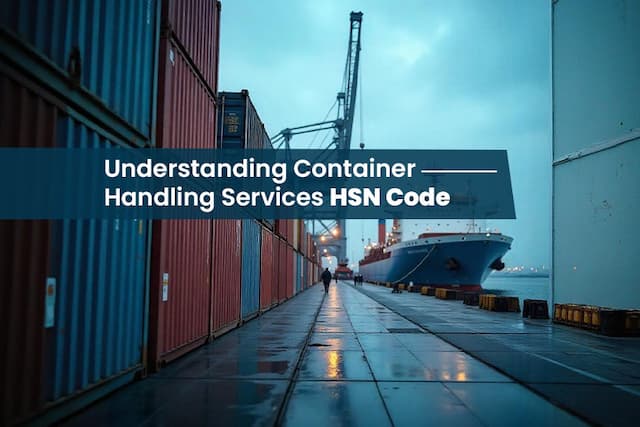The Harmonized System of Nomenclature (HSN) serves as a global coding system crucial for efficiently classifying goods in the realm of international trade. Functioning as a universal language for product categorization, the HSN greatly facilitates consensus in trade negotiations between countries. Within this comprehensive system, specific codes are assigned to various commodities, ensuring a standardized approach to their identification and classification.
Cement, a fundamental construction material, is no exception, having its distinct HSN code.
The specialized HSN code for cement plays a pivotal role in distinguishing and organizing the myriad types of cement during cross-border transactions. This coding system essentially acts as a set of rules, streamlining the complexities associated with the international trade of cement.
It functions as a common understanding or a shared vocabulary that transcends linguistic and regulatory barriers when discussing cement on a global scale. By adhering to the HSN, nations engaging in trade agreements can enhance the efficiency and transparency of transactions involving cement, fostering a more organized and harmonious global trade environment for this vital construction material.
What is the HSN Code for Cement
The HSN code for cement, designated as 2523, is a specialized six-digit classification system employed in international trade to categorize various types of cement. This code plays a crucial role in identifying and classifying cement products based on factors such as composition, quality, and intended use, streamlining import and export procedures for this essential construction material.
Importance of HSN for Cement
Below are some of the reasons why an HSN code for cement is important.
Trade Facilitation: HSN for cement streamlines international trade by offering a standardized classification system.
Identification and Classification: It aids importers and exporters in correctly identifying and classifying cement products.
Cost Reduction: Proper use of HSN codes helps avoid delays and reduces costs associated with trade transactions.
Regulatory Compliance: Many countries have regulations requiring HSN codes for cement imports and exports.
Regulatory Alignment: It ensures compliance with specific regulations governing the international movement of cement products.
Streamlined Procedures: The use of HSN codes simplifies import and export processes for cement.
Statistical Tracking: Governments and organizations utilize HSN codes to track the flow of cement products between countries.
Data Accuracy: HSN for cement contributes to accurate and reliable statistical data on trade patterns.
Trade Trend Analysis: The system aids in analyzing trends and patterns in the import and export of cement on a global scale.
Simplifying Cement Classification for Global Trade
Six-Digit Classification System: The HSN for cement utilizes a six-digit code to categorize products according to their composition, quality, and intended use. The first two digits (25) signify that the item is a mineral product, while the third digit (2) designates it as a type of cement.
Detailed Product Identification: The remaining three digits in the code provide a more detailed classification, specifying the cement’s unique properties and intended use. For instance, in the HSN code 2523 29 10, the code 329 signifies that the cement is specifically Portland cement. This system allows for the precise identification and differentiation of various types of cement in international trade.
Different Cement HSN Codes for Global Trade
Discovering the diverse world of cement is made simpler through specific HSN codes assigned to each type. Here are some examples:
| Cement Product | HSN Code |
| Portland Cement | 2523 29 10 |
| White Cement | 2523 21 00 |
| Colored Cement | 2523 10 00 |
| Hydraulic Cement | 2523 90 20 |
| Slag Cement | 2523 90 30 |
| Pozzolanic Cement | 2523 90 50 |
| Super Sulfate Cement | 2523 90 60 |
Each unique HSN code corresponds to the composition, quality, and intended use of the respective cement type, offering a systematic approach to international trade.
HSN Codes For Cement Products and Accessories
Beyond cement types, a variety of products and accessories also have distinct HSN codes. Here are some examples:
| Cement Product | HSN Code |
| Cement Clinkers | 2523 10 00 |
| Cement Bricks | 6810 11 90 |
| Cement Tiles | 6907 22 00 |
| Cement Pipes | 6810 11 90 |
| Cement Bags | 3923 21 00 |
| Cement Mixers | 8474 31 00 |
Each product and accessory carries a specific HSN code, providing a systematic classification based on composition, quality, and intended use, contributing to the efficiency of international trade in the realm of cement.
HSN Code Determination Guide For Cement
Determining the HSN code for your cement products is crucial for smooth import or export processes. Here’s a straightforward guide:
Check the Official HSN List: Refer to the official Harmonized System of Nomenclature (HSN) list specific to your country or region. This list is readily available and outlines the HSN codes for various types of cement and related products.
Identify Your Product Type: Understand the nature of your cement product – whether it’s a specific type of cement, an accessory, or a related item like bags or mixers.
Consult the HSN Code: Look for the corresponding HSN code on the list that best fits your product. For instance, if you are dealing with cement clinkers, check the HSN code under that category.
Review Applicable Rules and Regulations: Alongside the codes, be aware of any rules and regulations associated with your product. This information may include specific import/export guidelines and compliance requirements.
Stay Updated: The HSN system undergoes occasional changes, so stay informed about any updates or revisions. Regularly check for the latest information to ensure you are using the most current and accurate HSN codes for your cement products.
By following these steps and staying informed, you can confidently determine the correct HSN code for your cement products, ensuring compliance with regulations and facilitating smooth international trade transactions.
Final Words
In conclusion, understanding the HSN for cement is like having a global language for trade. It makes things easier when buying or selling cement across countries. Each type of cement and its products has a special code, ensuring everyone knows what they are talking about. This system helps countries agree on trade deals and keeps everything organized.
Remember, finding the right HSN code for your cement is crucial. Follow the simple guide: check your country’s HSN list, know your product, find the right code, understand the rules, and stay updated. This ensures smooth trade and follows the rules. Just like a universal translator, the HSN for cement simplifies international transactions, making sure everyone speaks the same language when it comes to this essential construction material.
Also Read: HSN Codes: What You Need to Know for Trade and Taxation
FAQs
Q1: What are the old and new GST rates of cement?
The GST rate of Cement has been reduced to 18% from 28% effective 22nd September 2025.
Q2: Are HSN codes for cement the same in all countries?
HSN codes for cement can differ between countries due to unique local regulations and trade agreements.
Q3: What happens if I use the wrong HSN code for my cement products?
Incorrectly using the HSN code for your cement products may lead to delays, penalties, and legal complications. It’s crucial to refer to the official HSN list and verify that you are applying the accurate code to avoid such issues.
Q4: How often do HSN codes for cement change?
HSN codes for cement are subject to periodic changes, influenced by updates to the system or changes in local regulations. Staying informed about these revisions is essential to ensure the use of the most current and accurate codes.
Also Read: Demystifying HSN Codes: Impact on Your Business and Its Significance





